Two highly acclaimed board games with roughly similar game mechanics, but vastly different themes. Scythe vs Terraforming Mars. What do they have in common and where they differ?
And most importantly, which one should you buy?
Scythe facts
Year published: 2016
Number of players: 1-5
Playing time: 1-2 hours
Suggested player age: 12+
Complexity rating (according to BGG): 3.39/5
Average rating (according to BGG): 8.3/10
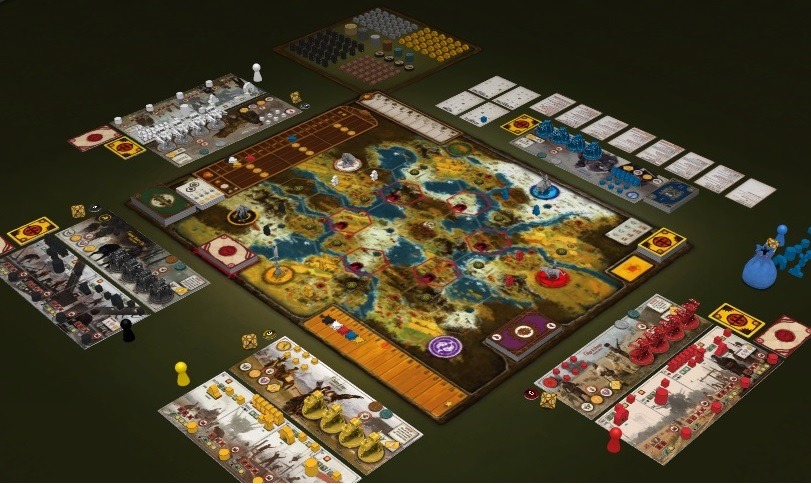
Main features:
- Great artwork and theme.
- A polished blend of many game mechanics.
- Terrific game components.
Major Expansions:
Alongside several encounter promo cards, three larger expansions have been published. The first one adds two new factions, The Wind Gambit introduces airships as movable units on the board, while Fenris’s main attraction is a story-driven campaign. All three greatly enrich the basic experience and are excellent choices. Get the base game first, of course.
- Invaders from Afar
- The Wind Gambit
- The Rise of Fenris
Click here to read my full review of Scythe
Terraforming Mars facts
Year published: 2016
Number of players: 1-5
Playing time: 1-2 hours
Suggested player age: 12+
Complexity rating (according to BGG): 3.23/5
Average rating (according to BGG): 8.4/10
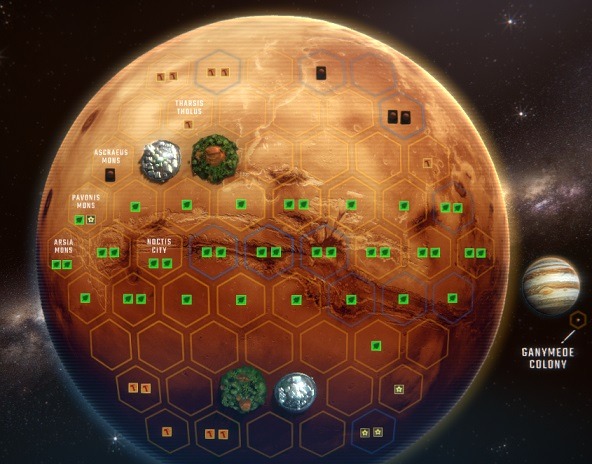
Main features:
- Immersive sci-fi theme.
- A lot of different balanced paths.
- Very good single-player mode.
Major Expansions:
Five expansions are available to enhance your Terraforming Mars experience. Even though the base game offers plenty of replayability, they are still a welcomed addition. The first four are smaller (and cheaper), adding minor features, while Turmoil is larger, adding a political layer to the gameplay.
- Hellas & Elysium
- Venus Next
- Prelude
- Colonies
- Turmoil
Click here to read my full review of Terraforming Mars
Fixed Map
A fixed hexagonal map is in the center of both games. In Scythe, you’re condemned to the same map every game, while Hellas & Elysium for Terraforming Mars offers two new maps, giving you fresh alternatives.
But this is negated by the “liveliness” of the map in Scythe: encounters and locations for building bonuses are different each time. Moreover, you can move your units on the map: workers can move from tile to tile and produce something else, and mechs can transport your workers and combat other players.
This produces a more dynamic and interactive experience, while in Terraforming Mars, you’ll play more of a static game, where placing and positioning is more important (you can’t really move an ocean, right?).
Interactivity in Scythe extends towards other players: you have to be more aware of what they’re doing, where are they going, how close they are to completing certain goals, and similar. In Terraforming Mars, you’re mostly concerned about your own corporation.
As a result, Scythe is much better in a group (even up to seven with Invaders from Afar), while Terraforming Mars suffers slightly from analysis paralysis and long downtime if the group is too large. It is best experienced in smaller numbers (e.g. 3 players).
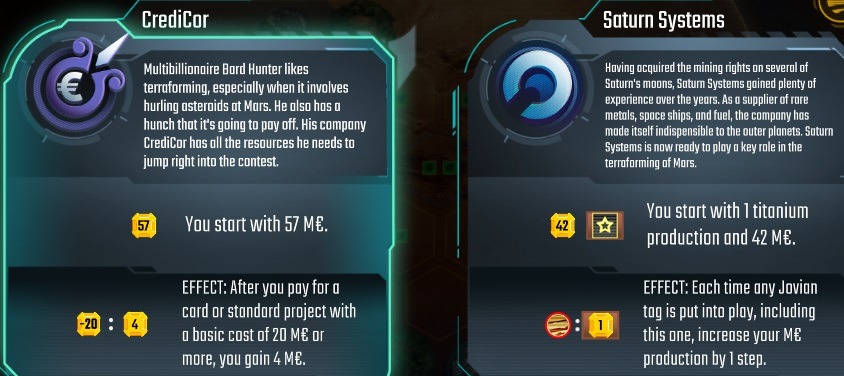
Asymmetric Factions
In the beginning, you will pick a unique faction that comes with its strengths and weaknesses. While there are more factions in Terraforming Mars, Scythe offers more differences between them, especially when combined with different player mats.
Engine Building
This is a particularly important aspect in both games. It’s something you will strive to optimize throughout your games and also something that is crucial for winning (or losing). Your faction will start out weak and turn by turn it will gain more resources and with greater ease.
There are numerous ways in achieving this in both games and they differ in their approach:
- Scythe’s engine is more straightforward and easier to build. You use resources to improve a certain area: build, enlist, upgrade, and deploy a mech.
- There is some of that in Terraforming Mars too (like building a powerplant), but it largely depends on cards. You can’t always do what you would want (i.e. increase your greenery production), you have to have a card that allows you to do that. If you don’t, tough luck.
Strong Theme
There’s no denying that the theme plays a strong role in the success of both games. Whether it’s a 1920s dieselpunk alternate reality world filled with mechs or the future, where we’re colonizing the Solar system, both themes are immersive. They are not an afterthought, but an integral element of game design.
Scythe is the more polished of the couple. It’s noticeable that art is the work of a true artist (Jakub Rozalski) and is consistent, including very nice miniatures. Terraforming Mars is a bit rough around the edges in that compartment and there’s definitely room for improvement.
Cool Expansions
I’ve listed the expansions above, there are three for Scythe and five for Terraforming Mars. All the expansions are of great value and aimed to enhance a specific aspect of a game.
And they succeed: adding new factions/corporations, new mechanics such as airships or politics, a new side map, or a campaign. You don’t have a feeling they are a money grab, but rather a valuable addition that fits into the base game perfectly.
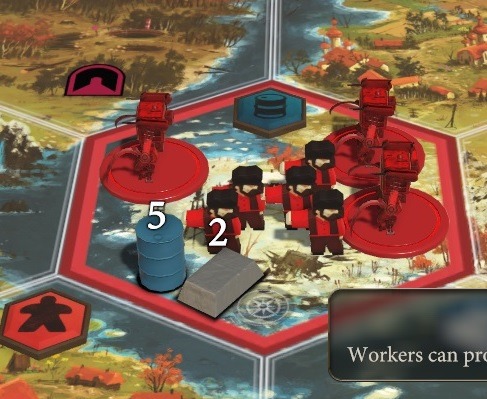
Very Good Solo Modes
Playing solo is becoming an attractive game mode in today’s board gaming and designers are acknowledging that. Both Scythe and Terraforming Mars are strong in that area, although they take a slightly different approach to the problem.
Scythe uses a clever artificial intelligence system (almost a trademark of Stonemaier games) that controls your opponent. The way you approach the game stays roughly the same. This mode is especially good with the story-driven Rise of Fernis expansion.
In Terraforming Mars, you have to adjust your game quite a bit. Your corporation is alone on Mars and you’ve got only 14 generations to terraform it. By yourself, that’s quite a challenge.
If you’re predominantly a solo gamer, there’s no doubt you will have fun with both games.
Excellent Digital Editions
Digital versions (Steam) of games have a lot of things in common. First, they are both published by Asmodee Digital. Both look visually stunning and the user interface is intuitive and easy to use.
Bots are capable and a challenge to play against and you can play online against other people or even in hot-seat mode on the same machine. Special mention goes to solo mode on Terraforming Mars, which is just perfect for a digital port and works brilliantly.
Price is similar and overall, both games are at the pinnacle of digital editions of board games. Buying them (or at least trying the 2-hour free trial period at Steam) is a must.
The only real negative is the lack of expansions, particularly for Scythe which only has Invaders from Afar available as DLC. Prelude and Hellas & Elysium are available for Terraforming Mars. Maybe the future will bring some more.
Scythe vs Terraforming Mars – Conclusion
If you’re on verge of buying one and just waiting for a simple answer, I’m going to disappoint you: you should get both!
We’re talking about two board games, that are easily creme de la creme of board gaming. While they may seem similar from a distance, each has a unique character, a soul even. If they interest you should play both at some point – or at least try digital editions of them.
Which one will you choose first, is up to your personal taste. Do you like sci-fi or diesel-punk?
Further reading:
Do you like what you just read? Consider subscribing for more content:
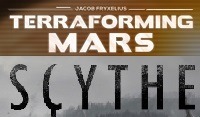
Great write-up of these two fantastic games. I love me some Scythe and I Terraforming Mars is my go to solo game. I’ve never gotten around t playing Scythe solo but you’ve tempted me to do so, I have just never dedicated the time to it because it seems a bit overwhelming but it may not be too bad since there is a dedicated instruction manual for it.
You’re like me then. I’ve played plenty of Terraforming Mars solo, namely on the digital edition. It’s so easy to get into and the games go by fast.
Haven’t played Scythe solo either, but the automa is said to be very good. Story-driven Rise of Fenris expansion seems to be the preferred mode of single-player.
That’s something I have on my to-do list for when I have the time. 🙂